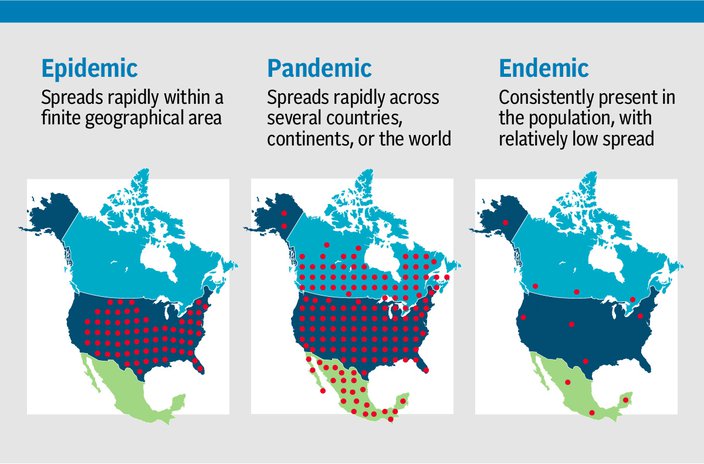
June 22, 2022
COVID-19 has wreaked havoc across the globe for more than two years. Now, many public health experts are debating whether the virus has transitioned from being a pandemic to being endemic.
But what do these terms mean and how does each phase impact society? Let’s take a closer look.
• Epidemic: A disease outbreak that spreads rapidly within a finite geographical area.
• Pandemic: A disease outbreak that spreads rapidly across several countries, continents, or the whole world
• Endemic: A disease that’s consistently present in the population, with relatively low spread
A disease usually becomes endemic only after the population develops a certain level of herd immunity against it. That is, when enough people develop antibodies against the disease — through becoming infected, getting vaccinated, or both — that the disease isn’t able to spread nearly as quickly.
Many diseases are endemic in the world today: the common cold, chicken pox, malaria, and hepatitis B, to name a few. But let’s focus on influenza (the flu), a perfect example of a disease that has transitioned from pandemic to endemic.
In 1918, influenza caused the most severe pandemic in recent history, infecting one third of the world’s population and causing at least 50 million deaths.
But as a result of that horrifying pandemic, and through the ensuing vaccination campaigns, a large percentage of the population developed a certain level of immunity against the flu. So now it’s endemic. It’s here to stay, but it’s predictable and seasonal; it tends to spread every fall and winter.
On average, the flu infects eight percent of the U.S. population every year. It tends to mutate frequently, causing new seasonal strains every year.
The flu isn’t harmless; it causes 12,000 – 52,000 deaths per year, and is especially dangerous to adults 65 and older, pregnant people, young children, and people with chronic health conditions.
Luckily, vaccines are fairly effective in protecting people against the flu, and it’s a good idea to get a flu shot every year.
Possibly the most important difference between a pandemic and an endemic is the public health response.
In a pandemic, the focus is on preventing transmission — through mask mandates, for example.
In an endemic, the focus is on keeping serious illness to a minimum and preventing hospitals from becoming overwhelmed. Vaccination is an important part of that strategy.
Whether COVID-19 is considered a pandemic or endemic, being vaccinated and getting boosted is vital to limiting the virus’s impact on us individually and on society as a whole.
This article was originally published on IBX Insights.
Dr. Reetika Kumar has served as medical director and vice president of Clinical Services at Independence Health Group since 2017. Her expertise and commitment to improving the health of our members is focused on proven practices, evidenced-based medicine, and cost-effective health care delivery. Reetika is a mom of two amazing kids and stays active during the pandemic with the Peloton Female Physicians group.
